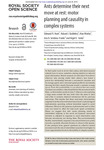Please use this identifier to cite or link to this item:
http://lib.hpu.edu.vn/handle/123456789/21850Full metadata record
| DC Field | Value | Language |
|---|---|---|
| dc.contributor.author | Hunt, Edmund R. | en_US |
| dc.contributor.author | Baddeley, Roland J. | en_US |
| dc.contributor.author | Worley, Alan | en_US |
| dc.date.accessioned | 2016-07-04T03:48:57Z | |
| dc.date.available | 2016-07-04T03:48:57Z | |
| dc.date.issued | 2016 | en_US |
| dc.identifier.other | HPU4160338 | en_US |
| dc.identifier.uri | https://lib.hpu.edu.vn/handle/123456789/21850 | en_US |
| dc.description.abstract | To find useful work to do for their colony, individual eusocial animals have to move, somehow staying attentive to relevant social information. Recent research on individual Temnothorax albipennis ants moving inside their colony’s nest found a power-law relationship between a movement’s duration and its average speed, and a universal speed profile for movements showing that they mostly fluctuate around a constant average speed. | en_US |
| dc.format.extent | 19 p. | en_US |
| dc.format.mimetype | application/pdf | en_US |
| dc.language.iso | en | en_US |
| dc.subject | Biology | en_US |
| dc.subject | Biocomplexity | en_US |
| dc.subject | Behaviour | en_US |
| dc.subject | Cognition | en_US |
| dc.subject | Complex social systems | en_US |
| dc.title | Exploration adjustment Ants determine their next move at rest | en_US |
| dc.type | Article | en_US |
| dc.size | 0.99MB | en_US |
| dc.department | Education | en_US |
| Appears in Collections: | Education | |
Files in This Item:
| File | Description | Size | Format | |
|---|---|---|---|---|
| 0221_ExplorationadjustmentAntsdetermine.pdf Restricted Access | 1.02 MB | Adobe PDF |  View/Open Request a copy |
Items in DSpace are protected by copyright, with all rights reserved, unless otherwise indicated.
